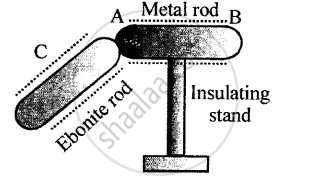Advertisements
Advertisements
प्रश्न
Figure below shows a metal rod AB placed on an insulating stand.
In figure (a) a negatively charged ebonite rod C is touched with the metal rod AB, while in figure (b), the negatively charged ebonite rod C is held near the rod AB. State the kind of charges at the ends A and B of the rod, in each case.

उत्तर
Explanation of Charges:
Case (a): The negatively charged ebonite rod C touches the metal rod AB
- When the ebonite rod C (negatively charged) touches the metal rod AB, electrons are transferred from the ebonite rod to the metal rod because metals are good conductors.
- Charges at the ends:
- End A: Negatively charged (electrons transferred from the ebonite rod).
- End B: Negatively charged (charge spreads evenly across the metal rod).
Case (b): The negatively charged ebonite rod C is held near the rod AB (without touching it)
- In this case, the induction process occurs:
- The negatively charged ebonite rod repels the free electrons in the metal rod AB, causing them to move to the far end (B).
- The end near the ebonite rod (A) becomes positively charged due to the deficiency of electrons.
- The far end (B) becomes negatively charged due to the accumulation of electrons.
APPEARS IN
संबंधित प्रश्न
Match the following
| Column A | Column B |
| Electric power | volt |
| kWh | joule |
| Electric current | volt × ampere |
| Electric energy | watt |
| watt | ampere |
| potential difference | electrical energy |
An ebonite rod can be charged by touching it with a charged copper rod.
Like charges ............while unlike charges attract.
An ebonite rod when rubbed with fur acquires the ............ charge.
A gold-leaf electroscope is to be charged positively by conduction. For this
The lightning conductor is made up of:
What do you understand by electricity at rest?
Can you charge an insulator by the method of conduction?
What are the effects of lightning?
State three safety measures that you will observe in thunder storm.
